Tóm tắt Luận án Nghiên cứu nồng độ H - Fabp trong chẩn đoán và tiên lượng nhồi máu cơ tim cấp
Nhồi máu cơ tim là một cấp cứu nội khoa nguy hiểm. Chẩn
đoán sớm và điều trị sớm nhồi máu cơ tim đóng vai trò quyết định trong
việc cứu sống bệnh nhân. Tuy nhiên, việc chẩn đoán sớm nhồi máu cơ
tim cấp vẫn còn là một thách thức bởi lẽ: triệu chứng lâm sàng nhiều
khi không điển hình; điện tim ghi nhận ban đầu thường có biến đổi
không đặc hiệu; các dấu ấn sinh học hiện hành - tiêu chuẩn chính để
chẩn đoán, lại phóng thích chậm sau tổn thương cơ tim và dương tính
giả trong một số trường hợp; các kỹ thuật hình ảnh chi phí còn khá
cao, không phải cơ sở nào cũng thực hiện được.
Vai trò của các dấu ấn tim trong chẩn đoán và theo dõi điều trị
được khẳng định trong các đồng thuận toàn cầu. Bên cạnh các dấu ấn
truyền thống, có nhiều dấu ấn sinh học mới được phát hiện và nghiên
cứu, trong đó H-FABP (Heart-type Fatty Acid Binding Protein) là một
điển hình. H-FABP vừa đặc hiệu cơ tim vừa xuất hiện sớm hơn các dấu
ấn tim hiện hành. Nhiều nghiên cứu cũng đã chứng minh giá trị tiên
lượng sau nhồi máu cơ tim của H-FABP, vai trò này độc lập với
troponin T, điện tâm đồ, xét nghiệm cận lâm sàng. Chính nhờ những
ưu điểm vượt trội này, H-FABP trở thành một dấu ấn tiềm năng. Tuy
nhiên, vẫn cần nhiều nghiên cứu đánh giá vị trí của H-FABP, nhất là
trong bối cảnh ra đời của test xét nghiệm hs troponin T thế hệ 4. Tại
Việt Nam, chưa có bất kỳ nghiên cứu nào tìm hiểu về vai trò của HFABP trong chẩn đoán sớm và tiên lượng nhồi máu cơ tim cấp. Chính
vì vậy, chúng tôi thực hiện đề tài nghiên cứu: “Nghiên cứu nồng độ HFABP trong chẩn đoán và tiên lượng nhồi máu cơ tim cấp”
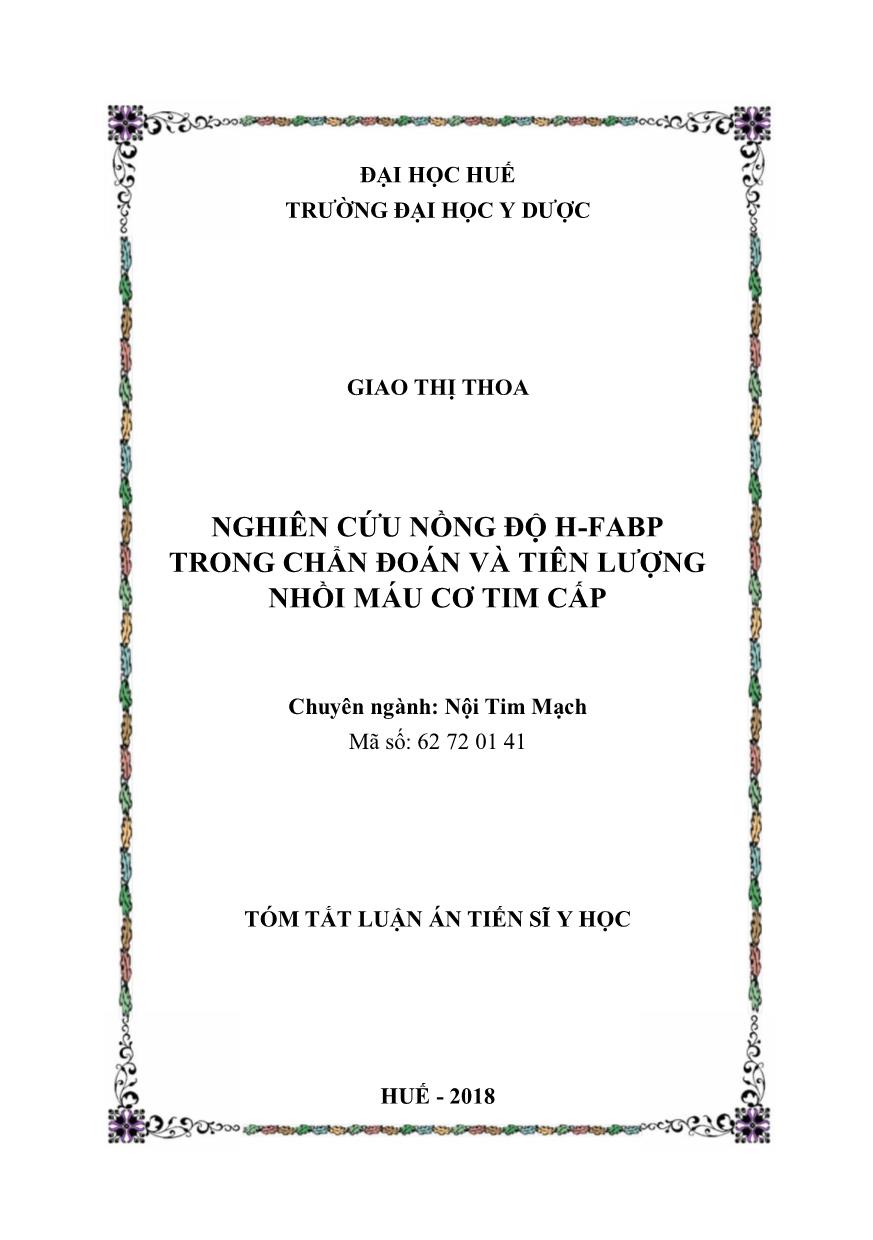
Trang 1

Trang 2
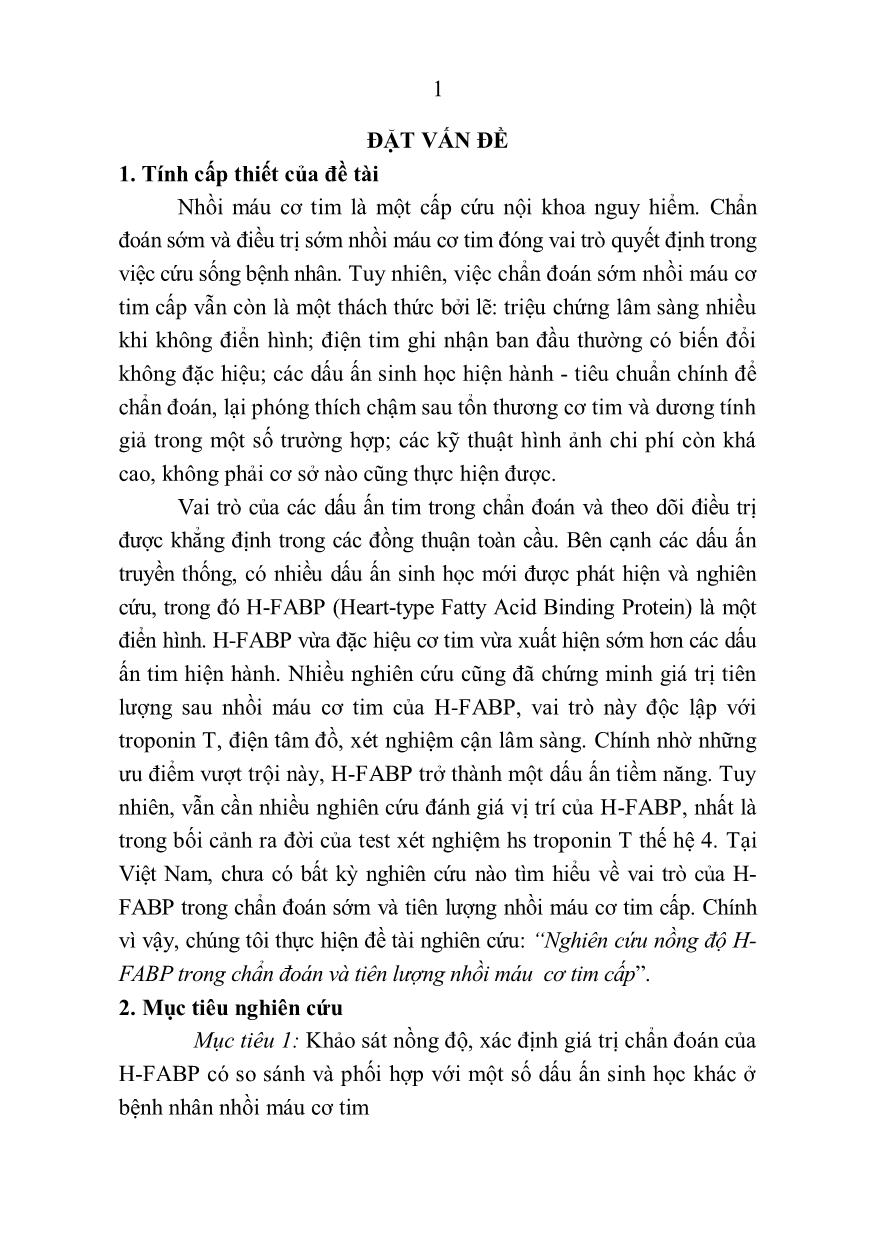
Trang 3
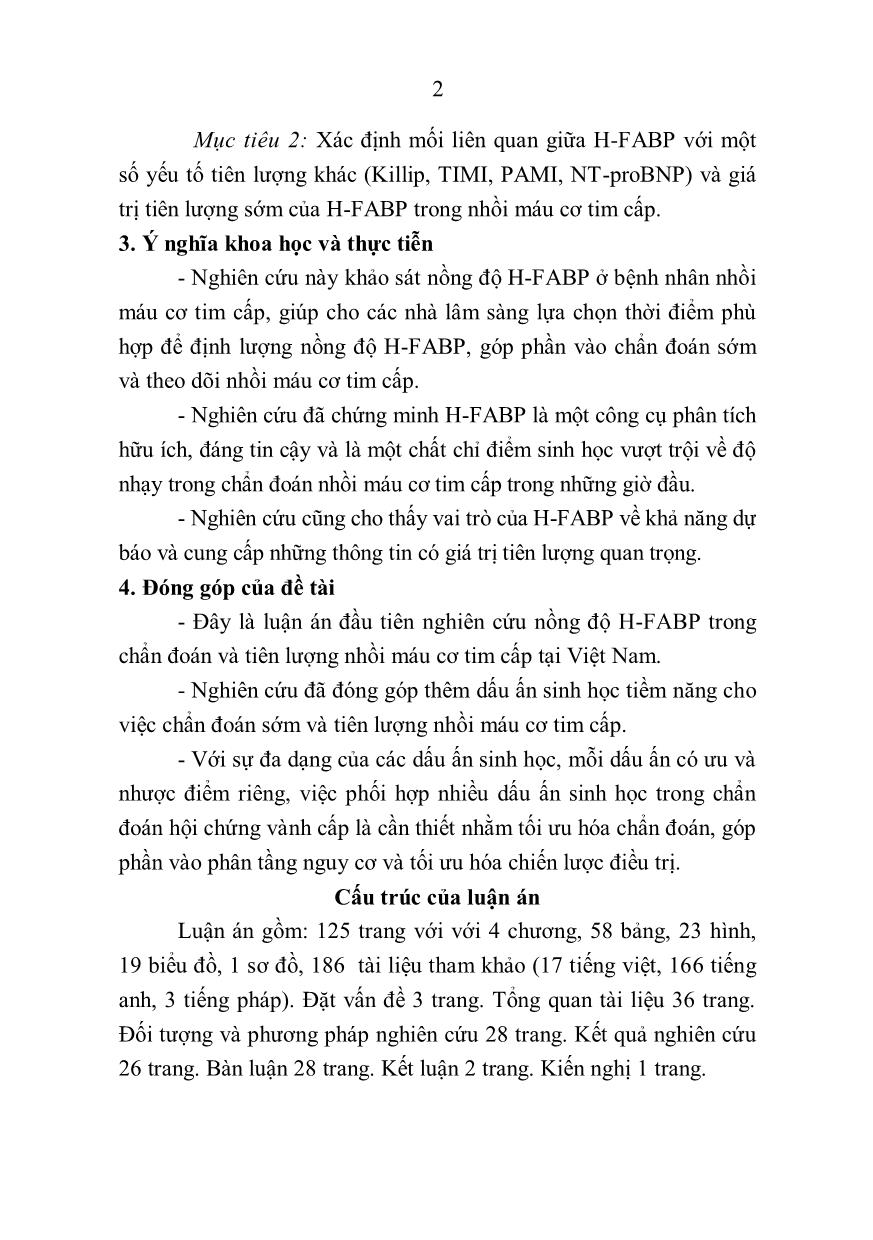
Trang 4
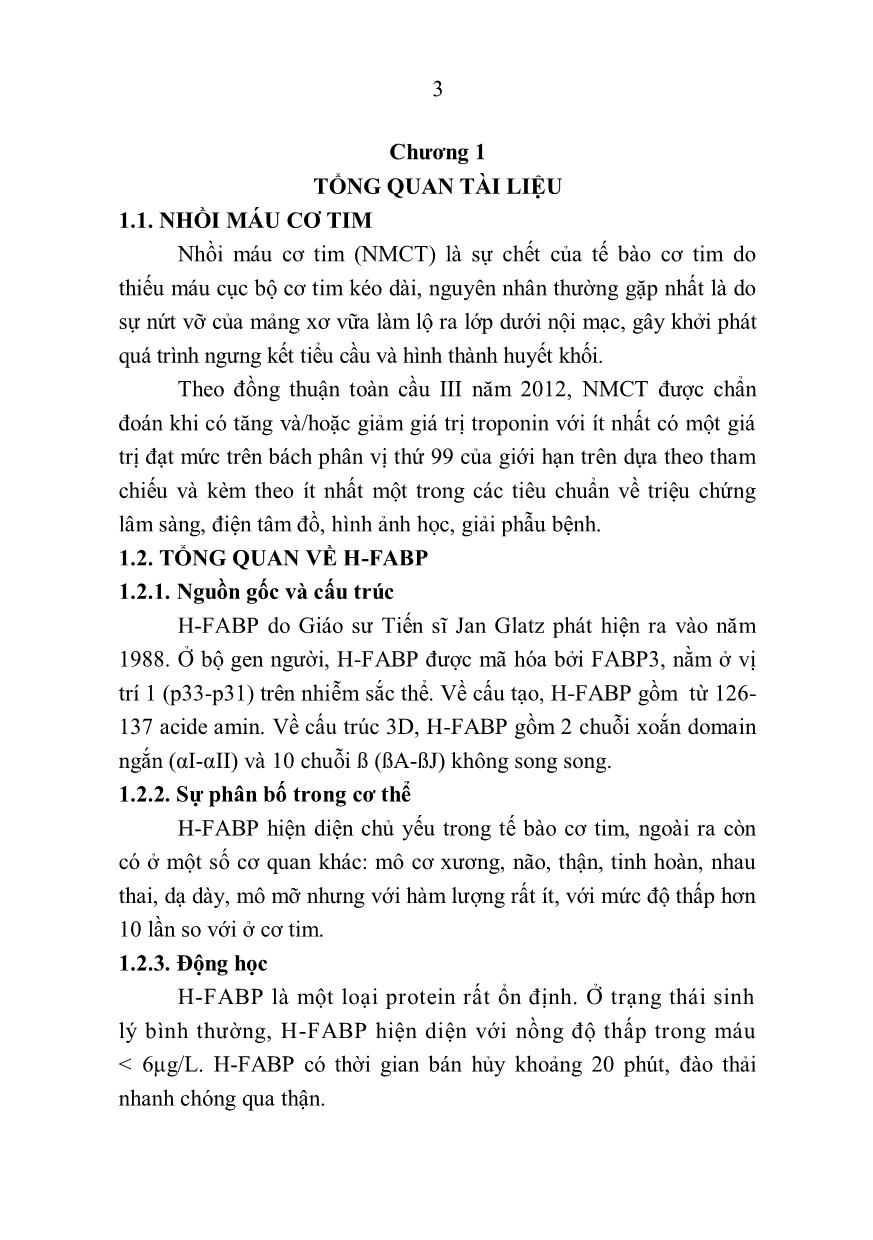
Trang 5
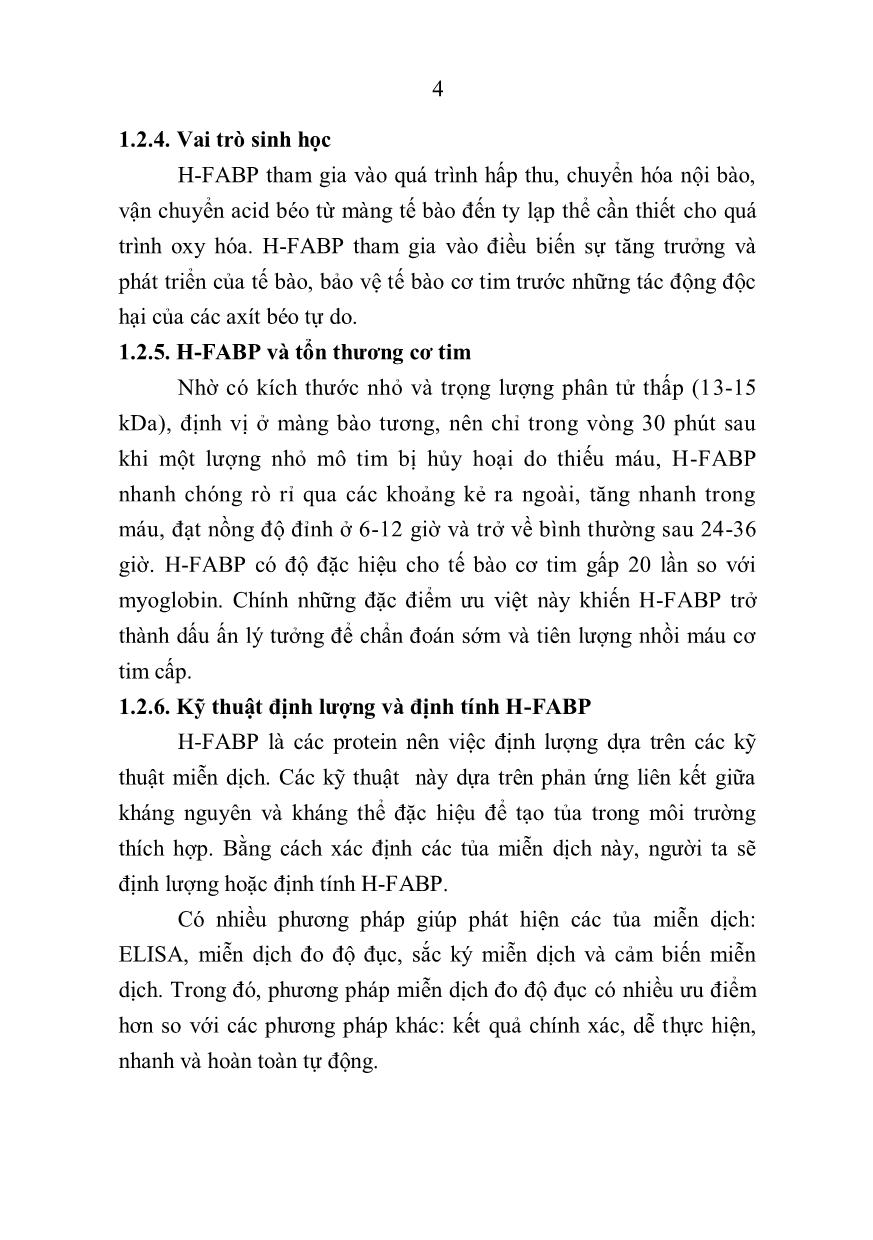
Trang 6
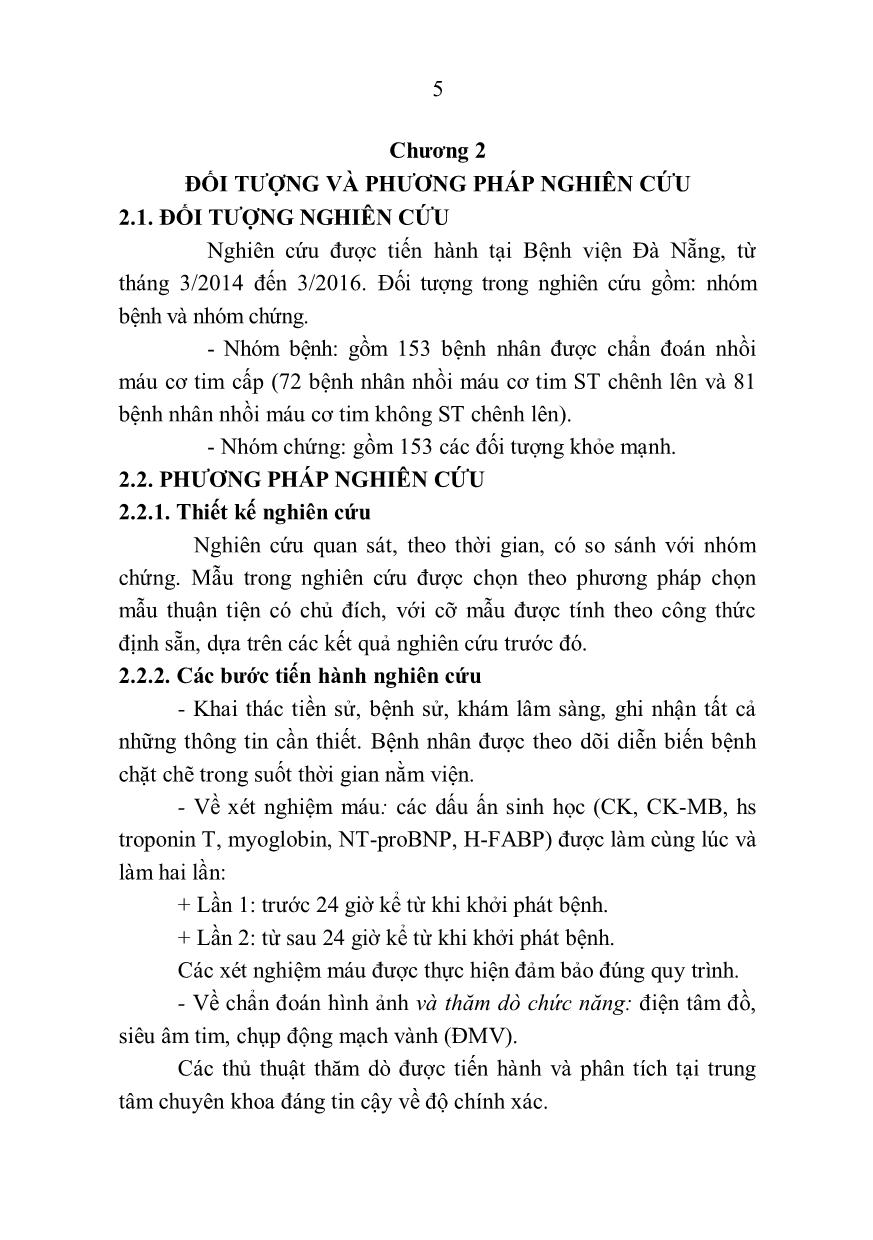
Trang 7
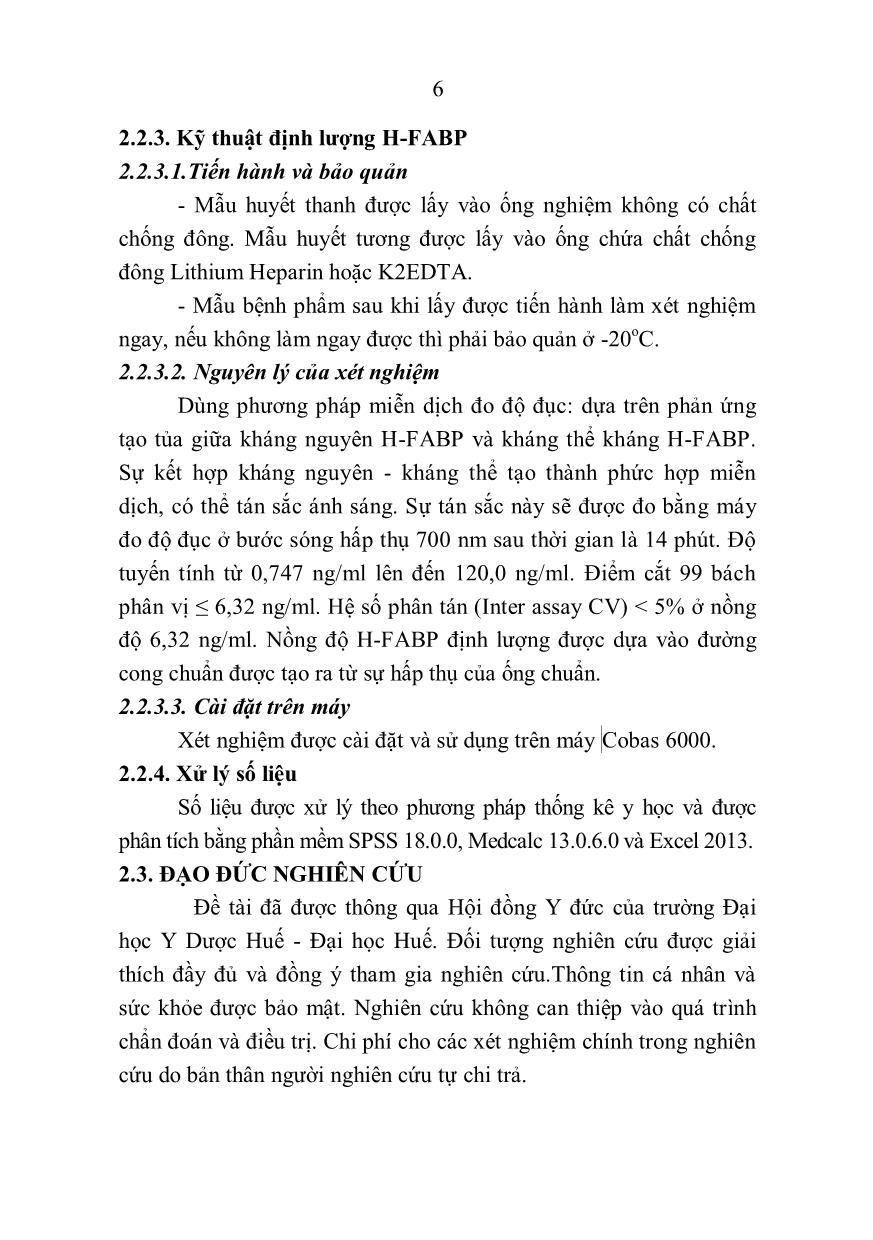
Trang 8

Trang 9
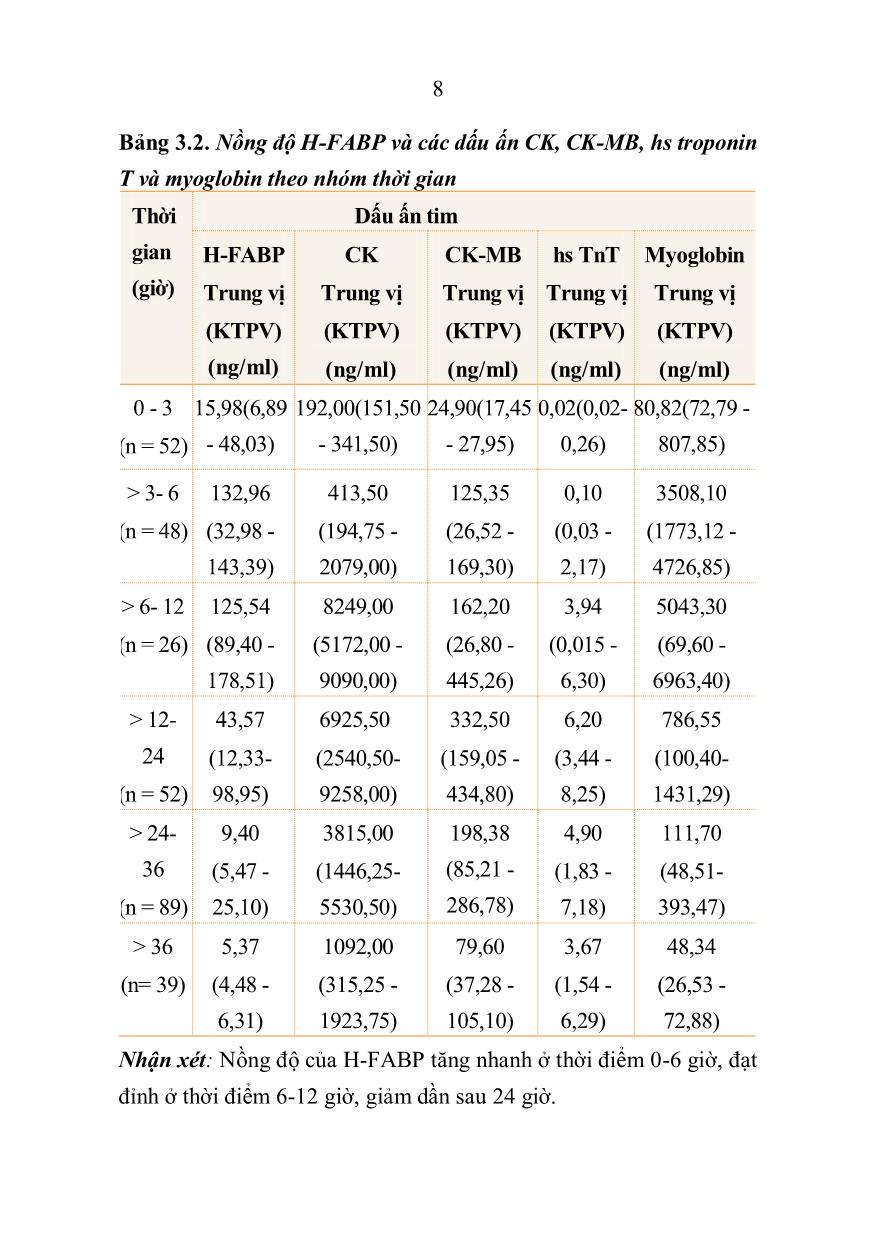
Trang 10
Tải về để xem bản đầy đủ
Tóm tắt nội dung tài liệu: Tóm tắt Luận án Nghiên cứu nồng độ H - Fabp trong chẩn đoán và tiên lượng nhồi máu cơ tim cấp
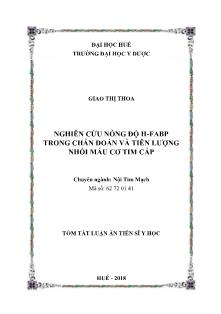
ĐẠI HỌC HUẾ TRƢỜNG ĐẠI HỌC Y DƢỢC GIAO THỊ THOA NGHIÊN CỨU NỒNG ĐỘ H-FABP TRONG CHẨN ĐOÁN VÀ TIÊN LƢỢNG NHỒI MÁU CƠ TIM CẤP Chuyên ngành: Nội Tim Mạch Mã số: 62 72 01 41 TÓM TẮT LUẬN ÁN TIẾN SĨ Y HỌC HUẾ - 2018 Công trình đƣợc hoàn thành tại Trƣờng Đại học Y Dƣợc Huế Ngƣời hƣớng dẫn khoa học: PGS.TS. NGUYỄN LÂN HIẾU GS.TS. HUỲNH VĂN MINH Phản biện1: Phản biện 2: Phản biện 3: Luận án sẽ được bảo vệ tại Hội đồng chấm luận án cấp Đại học Huế họp tại 03 Lê Lợi - Thành phố Huế vào lúc ..... giờ. .... ngày..tháng..năm Có thể tìm hiểu luận án tại: - Thư viện Trường Đại học Y Dược Huế - Thư viện Quốc gia 1 ĐẶT VẤN ĐỀ 1. Tính cấp thiết của đề tài Nhồi máu cơ tim là một cấp cứu nội khoa nguy hiểm. Chẩn đoán sớm và điều trị sớm nhồi máu cơ tim đóng vai trò quyết định trong việc cứu sống bệnh nhân. Tuy nhiên, việc chẩn đoán sớm nhồi máu cơ tim cấp vẫn còn là một thách thức bởi lẽ: triệu chứng lâm sàng nhiều khi không điển hình; điện tim ghi nhận ban đầu thường có biến đổi không đặc hiệu; các dấu ấn sinh học hiện hành - tiêu chuẩn chính để chẩn đoán, lại phóng thích chậm sau tổn thương cơ tim và dương tính giả trong một số trường hợp; các kỹ thuật hình ảnh chi phí còn khá cao, không phải cơ sở nào cũng thực hiện được. Vai trò của các dấu ấn tim trong chẩn đoán và theo dõi điều trị được khẳng định trong các đồng thuận toàn cầu. Bên cạnh các dấu ấn truyền thống, có nhiều dấu ấn sinh học mới được phát hiện và nghiên cứu, trong đó H-FABP (Heart-type Fatty Acid Binding Protein) là một điển hình. H-FABP vừa đặc hiệu cơ tim vừa xuất hiện sớm hơn các dấu ấn tim hiện hành. Nhiều nghiên cứu cũng đã chứng minh giá trị tiên lượng sau nhồi máu cơ tim của H-FABP, vai trò này độc lập với troponin T, điện tâm đồ, xét nghiệm cận lâm sàng. Chính nhờ những ưu điểm vượt trội này, H-FABP trở thành một dấu ấn tiềm năng. Tuy nhiên, vẫn cần nhiều nghiên cứu đánh giá vị trí của H-FABP, nhất là trong bối cảnh ra đời của test xét nghiệm hs troponin T thế hệ 4. Tại Việt Nam, chưa có bất kỳ nghiên cứu nào tìm hiểu về vai trò của H- FABP trong chẩn đoán sớm và tiên lượng nhồi máu cơ tim cấp. Chính vì vậy, chúng tôi thực hiện đề tài nghiên cứu: “Nghiên cứu nồng độ H- FABP trong chẩn đoán và tiên lượng nhồi máu cơ tim cấp”. 2. Mục tiêu nghiên cứu Mục tiêu 1: Khảo sát nồng độ, xác định giá trị chẩn đoán của H-FABP có so sánh và phối hợp với một số dấu ấn sinh học khác ở bệnh nhân nhồi máu cơ tim 2 Mục tiêu 2: Xác định mối liên quan giữa H-FABP với một số yếu tố tiên lượng khác (Killip, TIMI, PAMI, NT-proBNP) và giá trị tiên lượng sớm của H-FABP trong nhồi máu cơ tim cấp. 3. Ý nghĩa khoa học và thực tiễn - Nghiên cứu này khảo sát nồng độ H-FABP ở bệnh nhân nhồi máu cơ tim cấp, giúp cho các nhà lâm sàng lựa chọn thời điểm phù hợp để định lượng nồng độ H-FABP, góp phần vào chẩn đoán sớm và theo dõi nhồi máu cơ tim cấp. - Nghiên cứu đã chứng minh H-FABP là một công cụ phân tích hữu ích, đáng tin cậy và là một chất chỉ điểm sinh học vượt trội về độ nhạy trong chẩn đoán nhồi máu cơ tim cấp trong những giờ đầu. - Nghiên cứu cũng cho thấy vai trò của H-FABP về khả năng dự báo và cung cấp những thông tin có giá trị tiên lượng quan trọng. 4. Đóng góp của đề tài - Đây là luận án đầu tiên nghiên cứu nồng độ H-FABP trong chẩn đoán và tiên lượng nhồi máu cơ tim cấp tại Việt Nam. - Nghiên cứu đã đóng góp thêm dấu ấn sinh học tiềm năng cho việc chẩn đoán sớm và tiên lượng nhồi máu cơ tim cấp. - Với sự đa dạng của các dấu ấn sinh học, mỗi dấu ấn có ưu và nhược điểm riêng, việc phối hợp nhiều dấu ấn sinh học trong chẩn đoán hội chứng vành cấp là cần thiết nhằm tối ưu hóa chẩn đoán, góp phần vào phân tầng nguy cơ và tối ưu hóa chiến lược điều trị. Cấu trúc của luận án Luận án gồm: 125 trang với với 4 chương, 58 bảng, 23 hình, 19 biểu đồ, 1 sơ đồ, 186 tài liệu tham khảo (17 tiếng việt, 166 tiếng anh, 3 tiếng pháp). Đặt vấn đề 3 trang. Tổng quan tài liệu 36 trang. Đối tượng và phương pháp nghiên cứu 28 trang. Kết quả nghiên cứu 26 trang. Bàn luận 28 trang. Kết luận 2 trang. Kiến nghị 1 trang. 3 Chƣơng 1 TỔNG QUAN TÀI LIỆU 1.1. NHỒI MÁU CƠ TIM Nhồi máu cơ tim (NMCT) là sự chết của tế bào cơ tim do thiếu máu cục bộ cơ tim kéo dài, nguyên nhân thường gặp nhất là do sự nứt vỡ của mảng xơ vữa làm lộ ra lớp dưới nội mạc, gây khởi phát quá trình ngưng kết tiểu cầu và hình thành huyết khối. Theo đồng thuận toàn cầu III năm 2012, NMCT được chẩn đoán khi có tăng và/hoặc giảm giá trị troponin với ít nhất có một giá trị đạt mức trên bách phân vị thứ 99 của giới hạn trên dựa theo tham chiếu và kèm theo ít nhất một trong các tiêu chuẩn về triệu chứng lâm sàng, điện tâm đồ, hình ảnh học, giải phẫu bệnh. 1.2. TỔNG QUAN VỀ H-FABP 1.2.1. Nguồn gốc và cấu trúc H-FABP do Giáo sư Tiến sĩ Jan Glatz phát hiện ra vào năm 1988. Ở bộ gen người, H-FABP được mã hóa bởi FABP3, nằm ở vị trí 1 (p33-p31) trên nhiễm sắc thể. Về cấu tạo, H-FABP gồm từ 126- 137 acide amin. Về cấu trúc 3D, H-FABP gồm 2 chuỗi xoắn domain ngắn (αI-αII) và 10 chuỗi ß (ßA-ßJ) không song song. 1.2.2. Sự phân bố trong cơ thể H-FABP hiện diện chủ yếu trong tế bào cơ tim, ngoài ra còn có ở một số cơ quan khác: mô cơ xương, não, thận, tinh hoàn, nhau thai, dạ dày, mô mỡ nhưng với hàm lượng rất ít, với mức độ thấp hơn 10 lần so với ở cơ tim. 1.2.3. Động học H-FABP là một loại protein rất ổn định. Ở trạng thái sinh lý bình thường, H-FABP hiện diện với nồng độ thấp trong máu < 6µg/L. H-FABP có thời gian bán hủy khoảng 20 phút, đào thải nhanh chóng qua thận. 4 1.2.4. Vai trò sinh học H-FABP tham gia vào quá trình hấp thu, chuyển hóa nội bào, vận chuyển acid béo từ màng tế bào đến ty lạp thể cần thiết cho quá trình oxy hóa. H-FABP tham gia vào điều biến sự tăng trưởng và phát triển của tế bào, bảo vệ tế bào cơ tim trước những tác động độc hại của các axít béo tự do. 1.2.5. H-FABP và ... and diagnostic value of H-FABP for MI within 0-6 hours in comparison with CK, CK-MB, hs troponin T and myoglobin Within 0-6 hours following the onset, the area under the ROC curve of H-FABP is 0.93 (KTC 95%: 0.89- 0.96), higher than that of hs troponin T at 0.91 (KTC 95%: 0.87- 0.94), myoglobin at 0.86 (KTC 95%: 0.81- 0.90) and CK at 0,81 (KTC 95%: 0.76- 0.86) and CK-MB at 0.83 (KTC 95%: (0.78 – 0.88). According to the study of Kitamura Mitsunobu (2013), the cut-off value is 6.2 ng/ml, the area under ROC curve (AUC) within 2-4 hours after onset is 0.947 compared to hs troponin T at 0.935 and CK-MB at 0.805. Within 0-3 hours following the onset, the sensitivity of H-FABP is 84.62% (Sp: 84.31%; 19 PPV: 64.71%; NPV: 94.16%), much better than that of hs troponin T at 78.85% (Sp: 95.42%; PPV: 85.42%; NPV: 92.99%) and other biomarkers. Within 3-6 hours, the sensitivity of the biomarkers increase. H-FABP increases from 84.62% to 91.67%; hs troponin T from 78.85% to 85.42%; CK-MB from 73.08% to 85.42% ; CK from 69.23% to 79.17%; myoglobin from 78.85% to 81.25%. According to the study of Ibrahim Elmadbouh (2012), the sensitivy of H-FABP, myoglobin, hs troponin T and CK-MB at 0-3 hours after the onset is 81.8 %, 72.7%, 81.8% and 81.8%, respectively and all of them increase to 100% after 3-6 hours. 4.2.2.3. Accuracy and diagnostic value of H-FABP for MI within 6-24 hours in comparison with CK, CK-MB, hs troponin T and myoglobin Within 6-24 hours after the onset of chest pain, the diagnostic accuracy of hs troponin T is 0.94 (KTC 95%: 0.90- 0.97), higher than that of H-FABP at 0.87 (KTC 95%: 0.8- 0.91). The areas under ROC curve (AUC) of CK and CK-MB after 6 hours are higher at 0.87 (KTC 95%: 0.81- 0.91) and 0.88 (KTC 95%: 0.83- 0.92) than those before 6 hours. As for myoglobin, the area under ROC curve (AUC) at this time is lower at 0.81 (0.75- 0.86). The change of AUC of other biomarkers after 6 hours are also recorded in many other studies. The study of Kurz (2011) shows that the AUC of hs troponin T stands at 0.817, higher than that of H-FABP at 0.808 and myoglobin at 0.781. Within less than 6-12 hours, the sensitivity of H-FABP stands at 84.62% and goes down to 74.07% at less than 12-24 hours. In contrast, the sensitivity of hs troponin T tends to go up, from 88.46% to 96.30%. The diagnostic value of the three remaining biomarkers is not high. The cut-off level of H- FABP is 4 ng/ml and it has a sensitivity of 95.8% within 6-8 hours, higher than that of hs troponin T (91.7%), but the sensitivity of hs troponin T after 12 hours is higher than that of H-FABP. When a comparion is made among different biomarkers, H- FABP has a good diagnostic value before 12 hours, optimal within 0-6 hours after the onset while hs troponin offers the best diagnostic value right after 6 hours, especially after 12-24 hours. The diagnostic value of the three biomarkers is much lower than that of H-FABP and hs troponin T. Due to this characteristic, the combination of different biomarkers will help make the best use of the advantage and mitigate disadvantage of each biomarker. 20 4.2.2.4. Accuracy and diagnostic value of H-FABP for MI within the first 24 hours after onset of chest pain in comparison with CK, CK-MB, hs troponin T and myoglobin When it comes to the accuracy, the areas under the ROC curve of H-FABP and hs troponin T are 0.91 and 0.92, respectively. In terms of their diagnostic value within 24 hours following an onset, hs troponin T offers the highest value (Se: 85.62%; Sp: 95.42%; PPV: 94.93%; NPV: 89.90%), followed by H-FABP (Se: 84.97%; Sp: 84.31%; PPV: 84.42%; NPV: 84.87%) and CK-MB (Se: 81.70%; Sp: 81.05%; PPV: 81.17%; NPV: 81.58% ). CK and myoglobin have a low diagnostic value with a respective sensitivity of 77.78% và 78.43%. These results are also recorded in the study of Banu where the sensitivity of hs-troponin T and H-FABP is 94% and 82%, respectively. The study of Reddy LL.(2016) shows that the sensitivity of hs troponin T is 86%, higher than that of H-FABP at 78%. Prior to 6 hours, H-FABP has a very good diagnostic value, better than that of hs troponin T and other biomarkers. This finding is extremely important since this is the golden time in AMI for doctors to diagnose the disease and decide on timely interventions in order to mitigate myocardial damage, improve the recovery of newly damaged areas as well as mitigate mortality rates and cardiovascular events. 4.2.3. Combination of H-FABP with other biomarkers in diagnosis of acute myocardial infarction When H-FABP is combined with hs troponin T, the sensitivity has increased to 91.90%. If all biomarkers are combined together, the sensitivity is the highest (92.81%). When H-FABP is combined with hs troponin T, then the sensitivity increases to 100% (LL Readdy et al. (2016). Therefore, the combination of all biomarkers will improve the sensitivity of the diagnosis at any time and this is really necessary, especially in the early stage of AMI when clinical and laboratory findings are ambiguous and doctors are too embarrassed to diagnose the case. 21 4.4. RELATIONSHIP BETWEEN H-FABP LEVEL AND PROGNOSTIC FACTORS (KILLIP, TIMI, PAMI, NT-PROBNP) AND EARLY PROGNOSTIC VALUE OF H-FABP IN AMI 4.4.1. Relationship of H-FABP and other prognostic factors of Killip, TIMI, PAMI and NT-proBNP Killip class is particularly significant in predicting mortality risk after myocardial infarction. H-FABP level is strongly positively correlated with Killip with the coefficient (rs) of 0.94 (p < 0.001). The study of Nurwahyudi (2014) shows that the H-FABP level increase with the severity of Killip class. The role of TIMI và PAMI risk scores have been evaluated in many experimental studies. There is a moderate correlation between H-FABP level and TIMI & PAMI risk scores, and the correlation coefficients (rs) are 0,352 and 0,368, respectively. The study of Dirk AAM Schellings (2016) shows the similar correlation. The H-FABP is also positively correlated with NT- proBNP with the coefficient (r) of 0.733 (p < 0.001). In the study of Ji Hun Jeong (2016), NT-proBNP is considered to have a positive correlation with H-FABP with the coefficient (r) of 0.438. 4.4.2. Early prognostic value of H-FABP in acute myocardial infarction There is a positive correlation between H-FABP and the number of complications after AMI with the correlation coefficient (rs) of 0.453 (p < 0.05). In the study of Yawei liu (2017), if H-FABP level is ≥ 15.47 ng/ml, cardiovascular events are more likely to happen compared to the case when its H-FABP value is less than 15.47 ng/ml. Death is a crucial event after acute myocardial infarction. When a simple logistic regression analysis is carried out, the predictive factors of in-hospital mortality after AMI include Killip classes (II-IV), three major coronary arteries and/or mainstem damaged, ejection fraction, H- FABP and NT-proBNP levels with p < 0.05. When all these variables are analysed in the multiple logistic regression model, Killip classes (II- IV), three major coronary arteries and/or mainstem damaged, ejection fraction, H-FABP and NT-proBNP levels are independent factors with p < 0.05 which can predict mortality after MI. This shows that H-FABP is 22 a prognostic factor of mortality independent of other factors. The study of Kiyoshi I. (2005) also demonstrates that H-FABP value has an independent prognostic role from cardiovascular risk factors. When the area under the ROC curve is used to define the cutoff level to predict death event, the AUC of H-FABP is 0.83 (95%: 0.75- 0.89), the AUC of NT-proBNP is 0.75 (95%: 0.66- 0.82), the AUC of Killip classes is 0.79 (95%: 0.71- 0.86). The comparison shows that the diagnostic accuracy of H-FABP is the highest, followed by Killip class and NT-proBNP. Based on the ROC curve, we have defined the cut-off levels of H-FABP (> 114,07 ng/ml), NT-proBNP (> 960 pg/mL) and Killip (> 2) to analyze predictive values for cardiovascular events. The findings demonstrate that the predictive and diagnostic value of H- FABP is better than those of other biomarkers. The sensitivity of H- FABP is 86,67% compared to 80,00% of NT-proBNP and Killip classes. When it comes to the different prediction of mortality rate, the mortality rate for cases with H-FABP > 114,07 ng/ml, cases with NT- proBNP > 960 pg/ml and Killip > 2 is 14,72 times, 7.14 times and 12.14 times, respectively. The combination of H-FABP with NT- proBNP and Killip help increase the specificity in the prediction of mortality after MI. When carrying out the Kaplan-Meier survival analysis in the patient group during their hospitalization, we have divided the levels of H-FABP into four sub-groups of Q1 ≤ 8.185 ng/ml, Q2 > 8.185- 67 ng/ml, Q3 > 67- 136.355 ng/ml and Q4 ≥ 136.355 ng/ml. The finding shows that the sub-group with H-FABP ≤ 8.185 ng/ml have a better chance of survival compared to other sub-groups. In the study of Ji Hun Jeong (2016), the levels of H-FABP are divided into the following sub-groups of < 7.4 ng/ml, ≥ 7.4 ng/ml , < 8.8 ng/ml and ≥ 8.8 ng/ml. For the sub-group with H-FABP ≥ 8.8 ng/ml, their mortality rate is 3.25 times higher than that of the sub-group with H-FABP < 7.4 ng/ml. Following the study of Viswanathan K (2010), if H-FABP is more than 6.48 ng/ml, the mortality rate is 2.62 times higher. These authors also demonstrate that the survival chance is satisfactory for the quartile of the lowest H-FABP. 23 CONCLUSIONS Through the research of H-FABP level with immuno- turbidimetric H-FABP assay in 153 patients with AMI and 153 healthy subjects, we have come to the following conclusions: 1. Characteristics of H-FABP level in AMI - H-FABP becomes detectable in blood very early within only 30 minutes after onset, increases very quickly, peaking at 6-12 hours with the median concentration of 125.54 (89.40- 178.51) ng/ml, then decreases gradually and returns to normal after 24-36 hours. 2. Diagnostic value of H-FABP for AMI compared and combined with CK, CK-MB, hs troponin T and myoglobin - The cutoff value of H-FABP in patients with AMI is more than 6.41 ng/ml. - The area under the ROC curve of H-FABP is the highest within 0-6 hours: 0.93 (95% CI: 0.89- 0.96) and the AUC of troponin hs is the highest within 6-24 hours: 0.94 (KTC 95%: 0.90- 0.97). -The sensitivity, specificity, positive predictive value and negative predictive value of H-FABP are 84.97%, 84.31%, 84.42% and 84.87%, respectively, lower than those of troponin T hs (85.62%, 95.42%, 94.93%, 86.90%), but higher than those of CK-MB (81.70%, 81.05%, 81.17%, 81.58%), CK (77.78%, 79.08%, 78.81%, 78.06%) and myoglobin (78.43%, 75.16%, 75.95%, 77.70%). - When H-FABP is combined with these biomarkers, then the sensitivity is 92.81%, the specificity is 74.51%, positive predictive value is 78.45%, and the negative predictive value is 91.20%. 3. Relationship between H-FABP and other prognostic factors (Killip, TIMI, PAMI, NT-proBNP) and their early prognostic values - There is a significant relationship between H-FABP and Killip classes (the difference among the groups is statistically significant with p<0.001). 24 - H-FABP level is strongly positively correlated with NT- proBNP (r = 0.733) with p < 0.001. - H-FABP level increases gradually from low-risk to high-risk patient groups according to TIMI and PAMI scores. There is a positive correlation between H-FABP and TIMI (rs = 0.352), PAMI (rs = 0.368) with p < 0.05. - There is a significant relationship between H-FABP and severity and number of complications with p<0.001). - H-FABP is an independent factor which can predict mortality risk during hospitalization successfully after MI (OR= 14.72) with p < 0.05. When H-FABP is combined with NT-proBNP or Killip class, it improves the prediction of mortality risk after AMI. - In case of the quartile of H-FABP level (> 136.355 ng/ml), the survival rate during hospitalization is low (p < 0.05). RECOMMENDATIONS 1. H-FABP should be used regularly in patients with suspected AMI and hospitalized early when clinical diagnostic criteria and ECG findings are not specific to detect the disease. By this way, we can detect the disease soon, avoid a misdiagnosis or omit essential diagnosis. 2. H-FABP level should be combined regularly with other biomarkers in patients with AMI to optimize diagnosis, contribute considerably to risk stratification, optimize treatment strategies and improve prediction and prognosis of disease outcome . LIST OF PUBLISHED STUDIES RELATED TO THE THESIS 1. Giao Thi Thoa, Nguyen Lan Hieu, Bui My Hanh, Huynh Van Minh (2013), “H-FABP, a new finding in early diagnosis in patients with acute myocardial infarction”, Journal of Practical Medicine, Issue No. 1 (857), pages 115-117. 2. Giao Thi Thoa, Nguyen Lan Hieu, Huynh Van Minh (2014), “Prognosis value of H-FABP, a new biomarker in acute myocardial infarction”, Journal of Medicine and Pharmacy - Hue University of Medicine and Pharmacy, Issue No. 22+23, pages 40-47. 3. Giao Thi Thoa, Nguyen Lan Hieu, Huynh Van Minh (2015), “Study of the variation of H-FABP concentration in early diagnosis of acute myocardial infarction”, Journal of Vietnamese Cardiology, Issue No. 72, pages 192-200. 4. Giao Thi Thoa, Nguyen Lan Hieu, Huynh Van Minh (2017), “Study of the combination of H-FABP with other biomarkers in early diagnosis and prognosis of acute myocardial infarction”, Journal of Vietnamese Cardiology, Issue No. 79, pages 43-50. Supervisor’s confirmation Prof. Dr. HUYNH VAN MINH
File đính kèm:
 tom_tat_luan_an_nghien_cuu_nong_do_h_fabp_trong_chan_doan_va.pdf
tom_tat_luan_an_nghien_cuu_nong_do_h_fabp_trong_chan_doan_va.pdf

